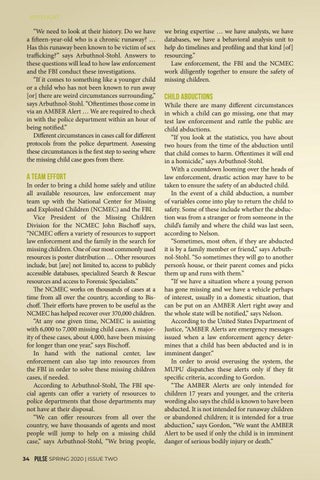SPOTLIGHT
“We need to look at their history. Do we have a fifteen-year-old who is a chronic runaway? … Has this runaway been known to be victim of sex trafficking?” says Arbuthnol-Stohl. Answers to these questions will lead to how law enforcement and the FBI conduct these investigations. “If it comes to something like a younger child or a child who has not been known to run away [or] there are weird circumstances surrounding,” says Arbuthnol-Stohl. “Oftentimes those come in via an AMBER Alert … We are required to check in with the police department within an hour of being notified.” Different circumstances in cases call for different protocols from the police department. Assessing these circumstances is the first step to seeing where the missing child case goes from there.
A Team Effort
In order to bring a child home safely and utilize all available resources, law enforcement may team up with the National Center for Missing and Exploited Children (NCMEC) and the FBI. Vice President of the Missing Children Division for the NCMEC John Bischoff says, “NCMEC offers a variety of resources to support law enforcement and the family in the search for missing children. One of our most commonly used resources is poster distribution … Other resources include, but [are] not limited to, access to publicly accessible databases, specialized Search & Rescue resources and access to Forensic Specialists.” The NCMEC works on thousands of cases at a time from all over the country, according to Bischoff. Their efforts have proven to be useful as the NCMEC has helped recover over 370,000 children. “At any one given time, NCMEC is assisting with 6,000 to 7,000 missing child cases. A majority of these cases, about 4,000, have been missing for longer than one year,” says Bischoff. In hand with the national center, law enforcement can also tap into resources from the FBI in order to solve these missing children cases, if needed. According to Arbuthnol-Stohl, The FBI special agents can offer a variety of resources to police departments that those departments may not have at their disposal. “We can offer resources from all over the country, we have thousands of agents and most people will jump to help on a missing child case,” says Arbuthnol-Stohl, “We bring people, 34
SPRING 2020 | ISSUE TWO
we bring expertise … we have analysts, we have databases, we have a behavioral analysis unit to help do timelines and profiling and that kind [of] resourcing.” Law enforcement, the FBI and the NCMEC work diligently together to ensure the safety of missing children.
Child Abductions
While there are many different circumstances in which a child can go missing, one that may test law enforcement and rattle the public are child abductions. “If you look at the statistics, you have about two hours from the time of the abduction until that child comes to harm. Oftentimes it will end in a homicide,” says Arbuthnol-Stohl. With a countdown looming over the heads of law enforcement, drastic action may have to be taken to ensure the safety of an abducted child. In the event of a child abduction, a number of variables come into play to return the child to safety. Some of these include whether the abduction was from a stranger or from someone in the child’s family and where the child was last seen, according to Nelson. “Sometimes, most often, if they are abducted it is by a family member or friend,” says Arbuthnol-Stohl. “So sometimes they will go to another person’s house, or their parent comes and picks them up and runs with them.” “If we have a situation where a young person has gone missing and we have a vehicle perhaps of interest, usually in a domestic situation, that can be put on an AMBER Alert right away and the whole state will be notified,” says Nelson. According to the United States Department of Justice, “AMBER Alerts are emergency messages issued when a law enforcement agency determines that a child has been abducted and is in imminent danger.” In order to avoid overusing the system, the MUPU dispatches these alerts only if they fit specific criteria, according to Gordon. “The AMBER Alerts are only intended for children 17 years and younger, and the criteria wording also says the child is known to have been abducted. It is not intended for runaway children or abandoned children; it is intended for a true abduction,” says Gordon, “We want the AMBER Alert to be used if only the child is in imminent danger of serious bodily injury or death.”
